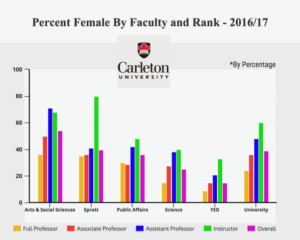Data presented to Carleton’s Senate has revealed a gendered divide in the number of male and female faculty at the university.
In a presentation on March 21, Peter Ricketts, the school’s provost and vice-president (academic), discussed the percentage of female faculty and contract instructors in each department during the 2016-17 academic year.
Overall, Carleton had 190 male full professors—tenure track professors—compared to 59 female full professors during the 2016-17 academic year. During the same time period, there were 55 female contract instructors compared to 36 males.
Root Gorelick, a senator for the Faculty of Science, said he was disappointed by the current statistics.
“It’s horrible. I think there are twice as many female contract instructors as male, and it’s almost exactly the opposite for tenure track,” Gorelick said. “There’s no good reason for it— it’s totally sexist.”

According to the report, of the 311 total professors and contract instructors in the Faculty of Arts and Social Sciences, only 25 are female full professors.
But the number of associate professors is tied—71 males and 71 females—while the number of both female assistant professors and contract instructors is greater than the number of males employed in the same ranks.
In the Faculty of Public Affairs, female faculty members only outnumber males in the rank of contract instructor, where eight females and two males were employed during the 2016-17 academic year.
Nineteen of the 57 total professors and contract instructors in the Sprott School of Business are female, with half as many full female professors as full male professors.
The Faculty of Science and Faculty of Engineering and Design had some of the most glaring divides between male and female faculty members.
Out of the 161 total professors and contract instructors employed in the Faculty of Science, only 41 are female. Ten are full professors, 14 are associate professors, 10 are assistant professors, and seven are contract instructors.
In the Faculty of Engineering and Design, 22 of the 155 total professors and contract instructors are women. There are five full female professors, 11 female associate professors, five female assistant professors, and one female contract instructor.
In contrast, the faculty employed 55 full male professors, 58 male associate professors, 18 male assistant professors, and two male contract instructors during the 2016-17 academic year.
However, the presentation noted that 79 per cent of librarians at Carleton are female.
Carleton has seen some improvement towards gender bias in faculty hires in recent years. In November 2010, 35 per cent of Carleton’s full-time academic staff was female, according to data presented by Ricketts at Senate meetings in 2015. By November 2014, the percentage had increased to 37 per cent.
The percentage of overall female faculty remains at 37 per cent with the data presented in March.
“I think that our faculty hiring should be a reflection of the population in general, or at least the population of our students,” Gorelick said.
“We should see the same diversity in our faculty members, be it contract instructors or tenure-track, that we see in our students, and we’re not seeing that.”
Photo credits: Miriam Abdel-Akher






